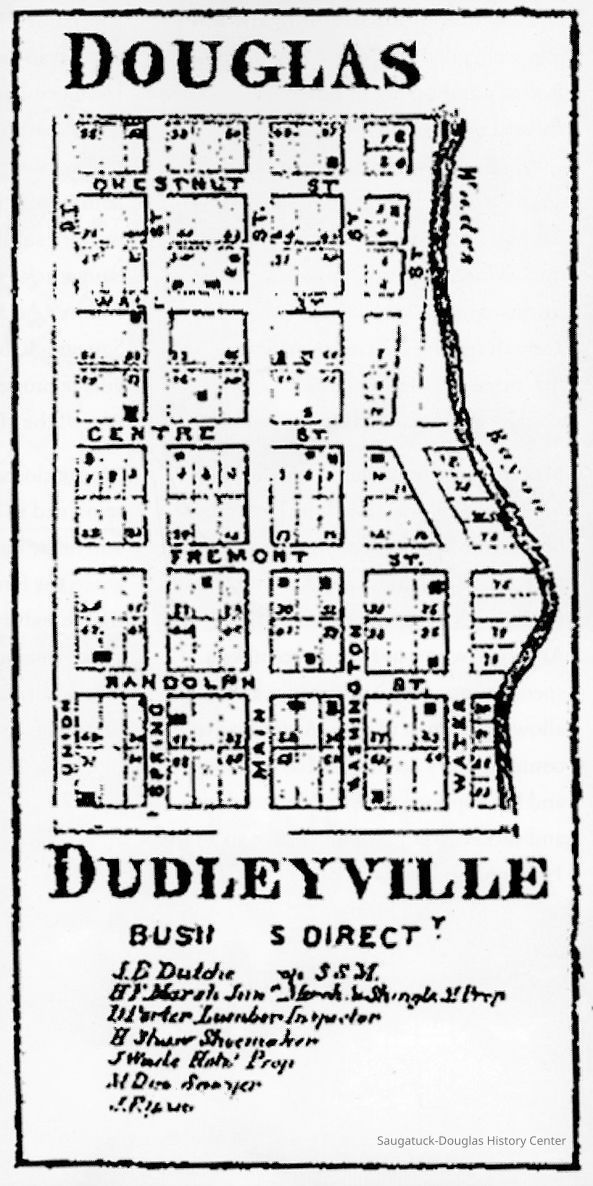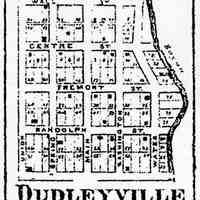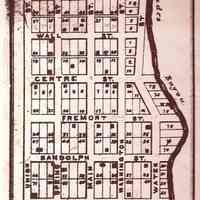Founding of Douglas, as told by William A. May

2023.50.109
About 1930 William A. May, the grandson of Douglas founder, William F. Dutcher wrote this summary of early Douglas history which was published in an Allegan newspaper. Its title is probably prompted by "Early Memories of Saugatuck" by May Francis Heath, which had just been published and included some question about the origin of the name of the Village of Douglas.
SDHS NL InsertsEducation and schools1830 Settlement, pioneer era1835 Logging and LumberingCommercial businesses
Winthers, Sally
2023.50
Found in Collection
SDHS Newsletter insert pages 409-412
Digital data in CatalogIt
May, William Augustus 1850-1935Dutcher, William Fuller 1800-1861May, Frederic HenryWade, Jonathan 1808-1868Crouse, Jonas S. 1824-1899
The beginning of the story of the founding and settlement of the village of Douglas, is across the sea, more than two hundred years ago, and concerns the history of the three families, all of English, Holland, or English-Holland origins, namely, May, Dietrich and Dutcher. In 1688, when William of Orange crossed the waters to England, leading English and Holland troops with him were some men named May, who afterwards became prominent and influential in Devonshire, England, and there, abut 1790, was born Edmund May, who later located at Douglas, Isle of Man, (midway between England, Ireland and Scotland in the Irish sea) became the father of Fredric Henry May, Later while engaged in constructing the Kalamazoo, Allegan and Grand Rapids Railroad, resided in Allegan and known as Colonel Fred H. May, who in due time gave to the village of Douglas its name. Some time in 1838 this May family came to America, locating at Milford, Pike county, Pennsylvania. In that section of the state, at or near lackawaxen was a family named Dietrich of "Pennsylvania Dutch" stock. One of the daughters was named Lucinda. Came a young man from out of the western New York by the name of Dutcher. He was of Holland descent, the ones who had occupied Nieuw Amsterdam under the Patroons. This man, William Fuller Dutcher, married Lucinda Dietrich. Their oldest daughter, Mary Anne, married young Frederic Henry May in the year 1848, and their oldest son, William Augustus May, was the original boy of Douglas, Michigan, as the Dutcher and May families, going to Chicago about 1853, found lodgement in 1855 on the present site of Douglas village. Mr. Dutcher having purchased from Jonathan Wade the land contained in the square bounded by Centre street from the riverside west to the corner where stands the Masonic hall, and hence north an a line leading straight to Kalamazoo lake, from there on the lake and river shore to the place of beginning. At a point near the present swing bridge where was the big saw mill, Mr. Wade had built a small mill containing one "muley" saw, which is an upright arrangement and very slow and hard to operate, turning out but a few hundred feet of lumber in a day. This small building was enlarged and remodeled, equipped with circular saws and other up to date machinery for making lumber, and operated by steam, was considered a modern plant. The locality was called "Mill Point. Near the mill was a grove of natural forest trees, (most of them are there now) and close to the grove was a small story and half cottage erected by Mr. Wade and which formed the nucleus of the long, low additions to the large two-story colonial-front house built for Dutcher, the most of which is, after more than seventy-five years, still in use as a good and comfortable home. It was in this big house facing the grove, that the early mill workmen were housed, because there was no other place for them. The mill building, blacksmith shop, a very old house on the river bank, and the "big" house constituted the settlement and were the only buildings in sight, the Wade home and the Dibble house over the Kenter way, not being visible owing to the large forest trees occupying everything in sight. The mill was after a time fitted for making lath, shingles, and turned wood articles, to which was added a grist-mill, the nearest grinding facilities being at Piercove. It was 1855 when the Dutcher family crossed lake Michigan from Chicago and their lumbering operations began. With them were Mrs. Marianne May and the little boy William, mother and son of Frederic H. May, Mr. May's wife having died in Chicago in the fall of 1854. Then came Martin Dietrich, brother of Mrs. Dutcher, with his wife, and twins Emma and Emmett. They first occupied the old gray house on the river bank just alluded to. Later arrived Mrs. Maria Graham, sister of Mrs. Dutcher, her son, Hugh E. Graham, her son-in-law Jonas S. Crouse and his wife Elizabeth, and some time later another son, Charles Graham and family. These people. constituted the first real settlers of "Mill Point," afterward locally called "Dutcherville," until formally and legally named "Douglas," the mill hands being counted as transient people and not real settlers. About 1860 it was decided to lay out the Dutcher property into village lots, and Mr. Dutcher's son-in-law, Fredric H. May, was commissioned to survey, plat and record the same. He accepted on condition of being permitted to name the town, which he called Douglas, after his birth-town in the Isle of Man. A copy of his map of Douglas was a few years ago, at least, hanging in the office of George L. Dutcher (son of Thomas B. Dutcher) in Fennville, and doubtless is in the possession of his family now. The name Douglas in the Manx tongue is from "Dhoo" (dark) and "Glass" (gray), "dark gray" from two rivers of those names which united near the city of Douglas, Isle of Man. When one remembers the colors of the Kalamazoo it is to find an additional reason for naming the Michigan village "Douglas." Mr. Dutcher had with him his elder son, George N., and wife Eliza; his second son, Thomas Benton (better known as "Bent") Dutcher, and a younger daughter, Elizabeth who later became the wife of Lewis A. Upson, a lake captain of sailing craft. The men were all Democrats in politics, and in the campaign of 1860, being supporters of Stephen A. Douglas, the Democratic nominee for president in opposition to Abraham Lincoln, Repubican nominee for president, many people got the idea that the town had been named in honor of Mr. Douglas, but that is not true, for Mr. May was in politics a rabid Republican and having the right to name the town would never have consented to call it after the Democratic nominee. Party feeling ran too high in those days for such a thing to be possible. Before the town site was laid out, efforts were made to secure the co-operation of Mr. Wade who could thus make possible the creation of a larger town site, but he would have none of it, and proceeded to plat a townsite of his own calling it "Dudleyville" after a brother who later came into the neighborhood with his large family, but the name did not please and in a few years the designation "Douglas" was applied to the whole section and additions to the village were entered as "Additions to the Village of Douglas." The first day-school in Douglas was kept in a small dwelling then on the ground now called the "square" (where baseball games are played), a Mrs. Whipple being the teacher. This lady afterward became Mrs. Robert MacDonald. Then a schoolhouse was built on what is now the corner diagonally opposite where the Masonic hall stands and the building is now the same as when first put up except for a small extension added to its front. When erected, the schoolhouse was at the top of a short steep hill, sandy in summer and dreadfully slippery in winter. This sharp grade has since been cut down to the present inconspicuous level. The hill was a fine place for coasting in wintertime. For a long time there were no church services, but after the little schoolhouse was ready far use, preaching was quite regularly had, the people undergoing much inconvenience by having to sit on the low and cramped places provided for the children at school. "Father Bliss" a Methodist circuit preacher, was the man who ministered to the community and by and by money was raised and the union meeting house was built. In this building was held our first Sabbath school. Hugh E. Graham was the superintendent, the house is now the I.O.O.F. hall, the Methodist organization having disbanded. The village grew in many new houses, new people and new industries. A new sawmill, the Marsh mill, was put into operation. This brought a new general store. The Gerber tannery was built and did a fine business. A Mr. Hayes started a tannery for curing deerskins, furs and fancy soft leathers. Mr. Wade built a large hotel calling it the Douglas House. Mr. Kibby was a landlord for years. A fine two-story schoolhouse was built. A drug store, a harness shop, butcher shop and a basket factory were added to the town. Many people were engaged in these industries. From spring to fall especially, the place was hustling from morn to night, and sometimes all night when the lumber mills were rushed with orders. There was a good population of excellent people. Douglas became a postoffice. Sailing and steam craft plied regularly between Douglas and Chicago and on the Kalamazoo river were steamers to Allegan. The Masonic hall is on the site of the original cemetery of Douglas,, all interred there being removed to a large and better location and the sharp hill was cut down to its present level, greatly improving the street and the town. This hall from its inception became the recreation centre of the community. Fine memories cluster around the village. its young people have ever been of the best. Its amusements, possibly simple, but always clean, its habits perfectly regular, its ideals high. Its joys and its sorrows are community joys and sorrows; we share them, one and all. Do not regret the smallness of the present town, or the passing of its departed activities, or its quietness and peace in winter. The town, with Saugatuck has became a favorite summer resort for Chicago people and such quietness and winter peacefulness make for true rest, not dullness ... The Forest it was many years before the natural forest trees of oak, sugar maple, whitewood, wild cherry, beech, basswood, sycamore, hemlock, ironwood, ash, hickory, black walnut, butternut, soft maple, pine, etc., disappeared.. From Hog Point all the way to Allegan along the river; in the big ravine just south of the village; an the ground near Aretas Bennett's home and east and south of Hugh Graham']s place and every foot of land west and south of the Wiley ground along the road to lake Michigan; the corner called Spencer's corner, and the interior of the country north, east and south and all the way to Allegan for many miles inland, stood giant trees of all kinds which in the passage of time were utilized for lumber, timber, tanbark, firewood, etc. or destroyed to clear ground for farming purposes. Fruits Fax grapes, thornapples, wild Indian apples, wild cherries, mandrakes, blackberries, red and black raspberries, wild plums, wild strawberries, sand-hill cherries, wintergreen bevies, and leaves, sassafras root, blue berries, love apples, and other natural fruits and herbs grew in abundance in the openings and other places. Wild flowers were plentiful and beautiful, it was a great pleasure to seek these things. Game Game was plentiful. Deer, squirrels, (red, black and gray), woodchucks, hedgehogs (porcupines), raccoons, wild ducks, wild geese, blackbirds, quail, grouse and countless flocks of wild pigeons all contributed to the pleasure and support of the community. Fur bearing animals such as muskrat, otter and skunk, wildcats and others were abundant; also owls of all kinds, whippoorwills, robins and many feathered songsters were found. The Pigeon Every spring from the south, and every fall from the north, came immense flocks of wild pigeons, so dense as to darken the sky, and so numerous as to be several days in passing a given paint. They often flew so low as to be readily knocked down with an ordinary pole. People shot and caught then in great quantities, in the fall putting the plucked pigeons carcasses down in jars of lard to resurrect and cook them when wanted during the winter. Pigeon pat pie was great stuff in those days. Fish Kalamazoo lake and river teemed with fish which were much sought and formed a considerable part of the fresh food supply. Black bass, small rock bass, calico bass or bream, sunfish, yellow perch, pike, pickerel, catfish, bull heads, muskellunge (big fellows, these), were most plentiful. Down at the mouth of the Kalamazoo the lake fishermen would supply whitefish, lake trout, and white perch. In both waters the sturgeon came every spring in large numbers. The Douglas mill men would take a farm wagon and go to the lake shore at three o'clock in the morning, armed only with a pike pole fitted with a plain hook, and as the sturgeon came to shore to spawn at daylight would draw them one by one upon the beach, dispatch them and take until they had secured a wagon load, when they would return home with the trophies of the expedition. It was pure waste, for little could be done with so many large fish, some of them weighing an hundred pounds, and the flesh made fit for eating had to be specially treated. The boys would make fine elastic bounding balls of the end of the sturgeon's nose and of the spinal corn, which resembled a huge muscle. There were dog fish, avaricious things, always taking bait or biting lines, and gar fish, long scaly and useless, fine big frogs, land turtles, mud turtles and big musky snapping turtles. These last were fine eating, sweet and delicate, and suckers speared at night in the springtime from boats carrying lighted "jacks" at the prows, a great sport for some people. Natural Beauty The physical and natural beauty of the land and surrounding of both Saugatuck and Douglas have never been properly exploited nor understood. If considered so attractive in those days, one may, after reading the foregoing, get a fleeting glimpse of a natural physical beauty that when carefully looked at and studied became more and more appealing to the senses as a picture will grown upon one's vision and open new attractions as they unfold to new points of view. It is no wonder then, that the easy people of Douglas drank in unconsciously the surrounding glory of the forest, the lake and river, the little hills and bluffs, the rolling ground and all nature's attractive goodness, learning to love and to remember after many days , the time of sojourn in a strange land. Some day a genius will come along and develop what others have neglected, and make more beautiful that which already is, and for these many years has been one of Nature's Jewels. Were those the happy days? Most decidedly yes! WM. A. MAY
This information was OCR text scanned from SDHS newsletter supplements. Binders of original paper copies are in the SDHC reference library.
01/07/2024
08/23/2025


